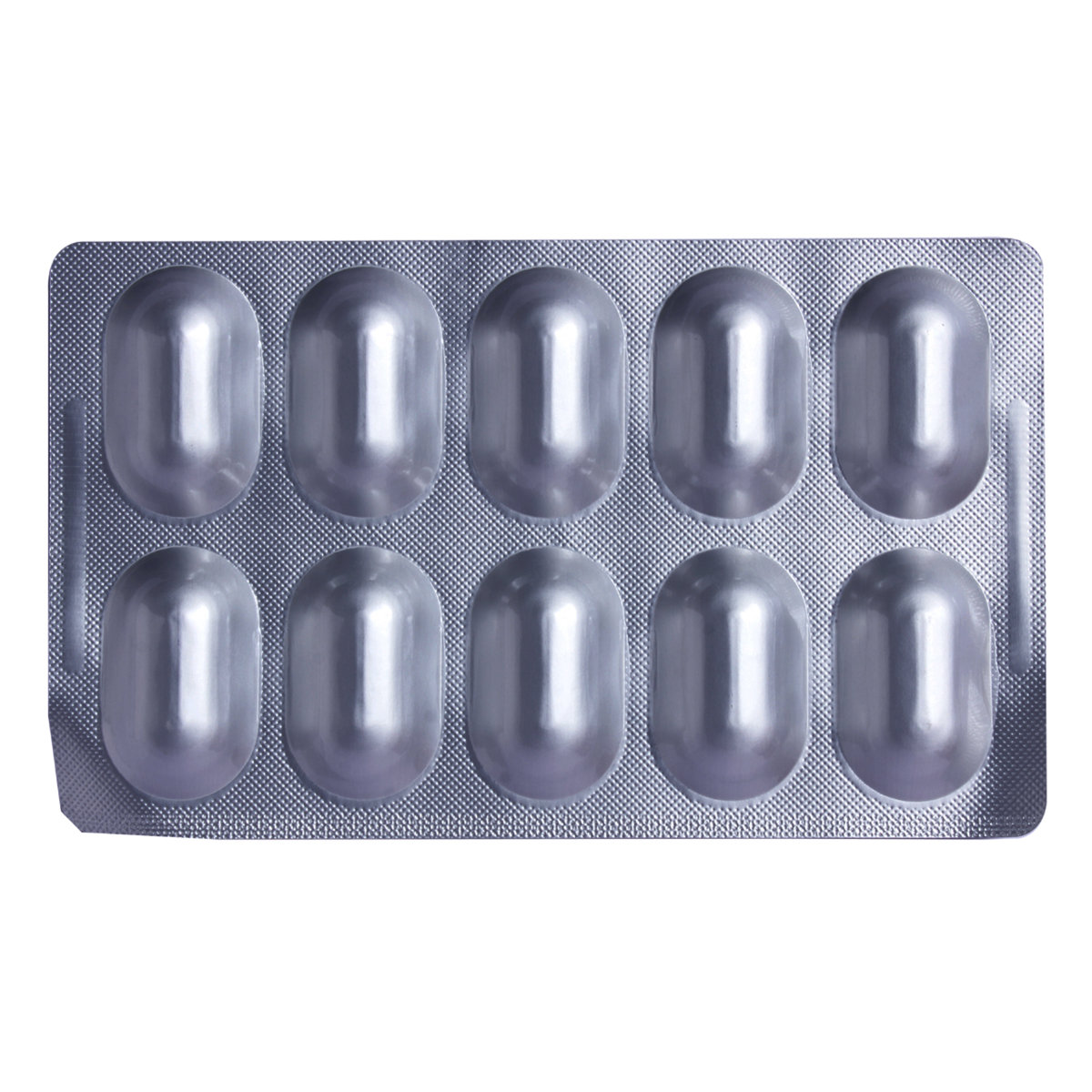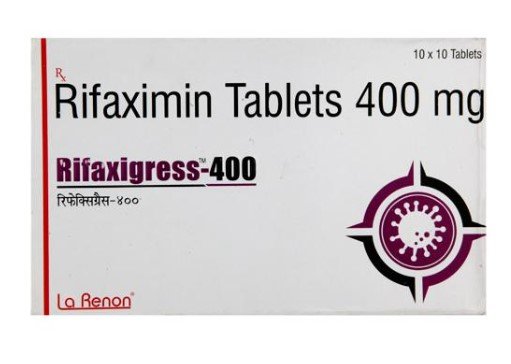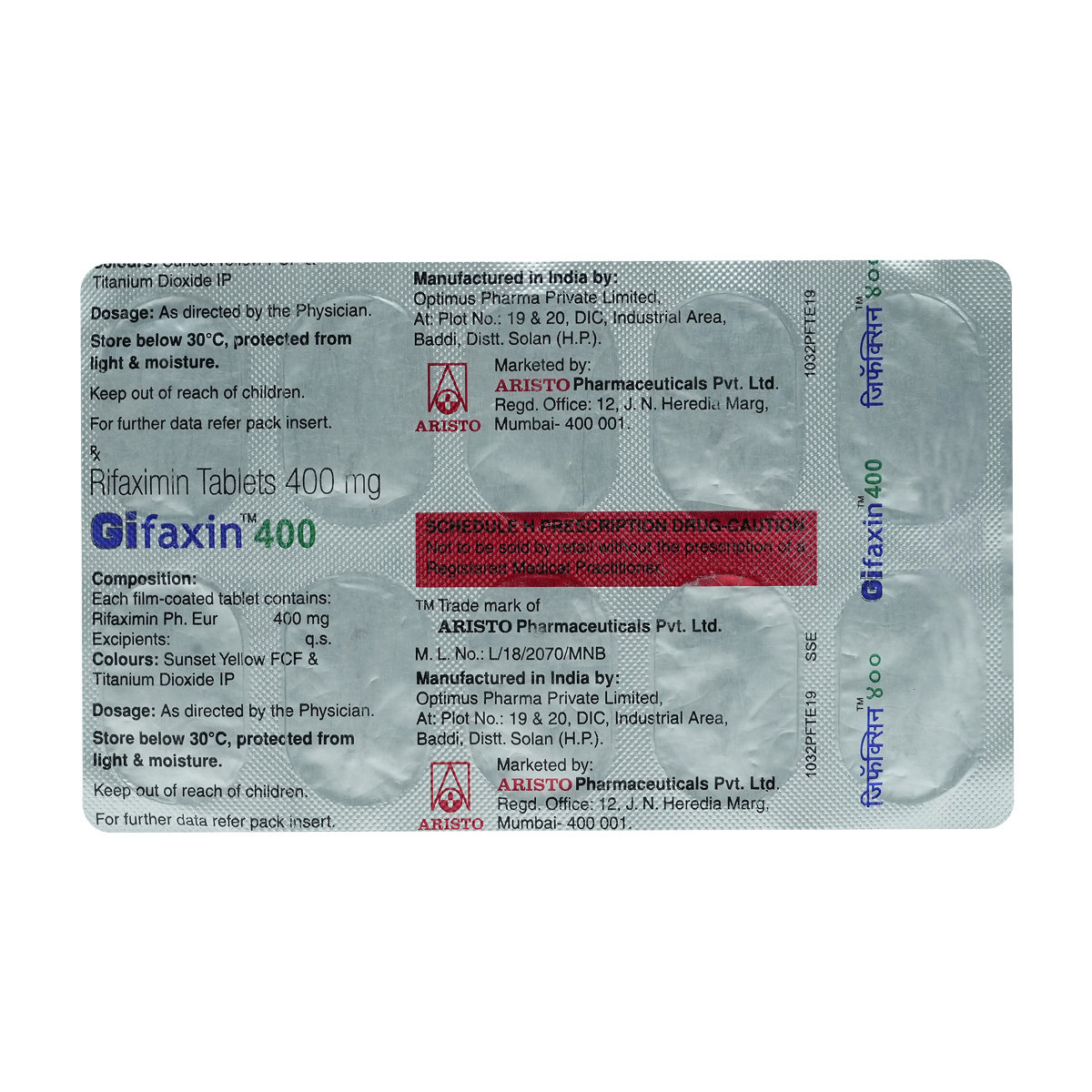Rifafix 400 mg Tablet 10's

MRP ₹397.5
(Inclusive of all Taxes)
₹59.6 Cashback (15%)
Rifafix 400 mg Tablet 10's is used to treat diarrhoea in children. It contains Rifaximin, an antibiotic which works by stopping the growth of bacteria that cause diarrhoea. In some cases, this medicine may cause side effects like nausea, flatulence, vomiting, constipation, and abdominal pain. Before starting the medicine, inform the doctor if your child is taking any other medicines or has other medical conditions.
Know Your Delivery Time
Provide Delivery Location

Secure Payment

India's Most Trusted Pharmacy

Genuine Products
Composition :
Manufacturer/Marketer :
Consume Type :
Return Policy :
Expires on or after :
About Rifafix 400 mg Tablet 10's
Rifafix 400 mg Tablet 10's is used in the treatment of traveller’s diarrhoea and infectious diarrhoea in children. Diarrhoea is a condition characterised by frequent bowel movements, resulting in loose, watery stools.
Rifafix 400 mg Tablet 10's contains Rifaximin, an antibiotic that works by stopping the growth of bacteria that cause diarrhoea. Thereby, it helps treat diarrhoea in children.
Sometimes, Rifafix 400 mg Tablet 10's may cause side effects such as nausea, flatulence, vomiting, constipation, and abdominal pain. Most of these side effects may not require medical attention and gradually resolve over time. However, if the side effects persist or worsen, reach out to the doctor.
Rifafix 400 mg Tablet 10's should be given by mouth with or without food as directed by your paediatrician. The dosage is based on your child's medical condition and response to treatment. It is advised not to give more than the recommended dose of medicine.
Let the doctor know if your child is allergic to Rifafix 400 mg Tablet 10's or any of the components in Rifafix 400 mg Tablet 10's. Keep the doctor informed about your child’s health condition and medications to rule out any side effects/interactions. This medicine is not recommended for use in pregnant and breastfeeding mother's.
Uses of Rifafix 400 mg Tablet 10's
Rifafix 400 mg Tablet 10's is used in the treatment of traveller's diarrhoea and infectious diarrhoea in children. The detailed uses of Rifafix 400 mg Tablet 10's are as follows:
- Treatment of infectious diarrhoea: Rifafix 400 mg Tablet 10's is primarily used to treat infectious diarrhoea.
- Traveller’s diarrhoea: Rifafix 400 mg Tablet 10's is also used for treating traveller’s diarrhoea.

Have a query?
Directions for Use
- Rifafix 400 mg Tablet 10's can be given with or without food.
- Follow your doctor's instructions regarding the dosage and duration of the medication.
- Administer the advised dose to the child using the measuring cup/measuring spoon/dropper.
- Avoid using regular household spoons, as they may not measure the dose correctly. Shake well before use.
Medicinal Benefits
- Rifafix 400 mg Tablet 10's belongs to the group of medicines called antibiotic agents used to treat traveller’s diarrhoea and infectious diarrhoea in children.
- Rifafix 400 mg Tablet 10's is a broad-spectrum antibiotic that is effective against gram-positive and gram-negative bacteria, aerobic and anaerobic bacteria, and ammonia-producing bacteria.
- This medicine is a gastrointestinal-selective antibiotic with a broad spectrum of antimicrobial activity.
- Rifafix 400 mg Tablet 10's is bactericidal in nature and works by killing the bacteria that cause infections. Thus, it helps in treating and preventing the spread of infections.
How Rifafix 400 mg Tablet 10's Works
Storage
- Tell your doctor about your GAS symptoms. They may change your medication regimen or prescribe additional drugs to help you manage them.
- To manage GAS symptoms, eat a balanced diet of fibre, vegetables, and fruits.
- Drink enough water throughout the day to avoid constipation and treat GAS symptoms.
- Regular exercise like yoga and walking may help stimulate digestion and alleviate GAS symptoms.
- Take probiotics only if your doctor advises, as they may help alleviate GAS symptoms by promoting gut health.
- Take medication for GAS symptoms only if your doctor advises, as certain medications can interact with your existing prescriptions or worsen symptoms.
- If symptoms persist, worsen, or are accompanied by severe abdominal pain, vomiting, or bleeding, seek immediate medical attention.
- Hydrate your body: Drink enough water to prevent dehydration and headaches.
- Calm Your Mind: Deep breathing and meditation can help you relax and relieve stress.
- Rest and Recharge: Sleep for 7-8 hours to reduce headache triggers.
- Take rest: lie down in a quiet, dark environment.
- Cold or warm compresses can help reduce tension.
- Stay Upright: Maintain good posture to keep symptoms from getting worse.
- To treat headaches naturally, try acupuncture or massage therapy.
- Over-the-counter pain relievers include acetaminophen and ibuprofen.
- Prescription Assistance: Speak with your doctor about more substantial drug alternatives.
- Severe Headaches: Seek emergency medical assistance for sudden, severe headaches.
- Frequent Headaches: If you get reoccurring headaches, consult your doctor.
- Headaches with Symptoms: Seek medical attention if your headaches include fever, disorientation, or weakness.
- Drink water or other clear fluids.
- To prevent worsening of pain, limit intake of tea, coffee, or alcohol.
- Include bland foods like rice, toast, crackers, and rice in your diet.
- Avoid lying down immediately after eating as it may cause indigestion or heartburn.
- Avoid acidic and spicy food as it may cause indigestion.
- Eat fiber-rich foods like whole grains, fruits, vegetables, and legumes to promote regular bowel movements.
- Drink plenty of water to soften stool and make it easier to pass.
- Avoid trigger foods like dairy, gluten, or spicy foods that can worsen constipation.
- Exercise regularly, like walking or yoga, to stimulate bowel movements.
- Practice yoga and pelvic floor exercises to strengthen muscles involved in bowel movements.
- Inform your doctor if you experience severe symptoms like abdominal pain, vomiting, or blood in the stool.
- Inform your doctor about the nausea and discuss possible alternatives to the medication or adjustments to the dosage.
- Divide your daily food intake into smaller, more frequent meals to reduce nausea.
- Opt for bland, easily digestible foods like crackers, toast, plain rice, bananas, and applesauce.
- Avoid certain foods that can trigger nausea, such as fatty, greasy, spicy, and smelly foods.
- Drink plenty of fluids, such as water, clear broth, or electrolyte-rich beverages like coconut water or sports drinks.
- Use ginger (tea, ale, or candies) to help relieve nausea.
- Get adequate rest and also avoid strenuous activities that can worsen nausea.
- Talk to your doctor about taking anti-nausea medication if your nausea is severe.
- Record when your nausea occurs, what triggers it, and what provides relief to help you identify patterns and manage your symptoms more effectively.
- Inform your doctor about your constipation symptoms. They may adjust your medication or advise alternative treatments.
- Stay hydrated by drinking sufficient of water (at least 8-10 glasses a day) to help soften stool and promote bowel movements.
- Increase fibre intake by eating foods high in fibre, such as fruits, whole grains, vegetables and legumes, to help bulk up the stool.
- Establish a bowel routine by trying to go to the bathroom at the same time each day to train your bowels.
- Engaging in regular exercise, like walking or yoga, can support in bowel movement stimulation.
- Consult your doctor if constipation persists, and discuss alternative treatments or adjustments to your medication.
- Inform your doctor immediately if you experience a fever after starting a new medication.
- Your doctor may adjust your medication regimen or dosage as needed to minimize fever symptoms.
- Monitor your body temperature to monitor fever progression.
- Drink plenty of fluids, such as water or electrolyte-rich beverages, to help your body regulate temperature.
- Get plenty of rest and engage in relaxation techniques, such as deep breathing or meditation, to help manage fever symptoms.
- Under the guidance of your doctor, consider taking medication, such as acetaminophen or ibuprofen, to help reduce fever.
- If your fever is extremely high (over 103°F), or if you experience severe symptoms such as confusion, seizures, or difficulty breathing, seek immediate medical attention.
What if I have taken an overdose of Rifafix 400 mg Tablet 10's
Drug Warnings
- Do not administer Rifafix 400 mg Tablet 10's to the child if they are allergic to any of its components.
- Inform the doctor if the child has kidney or liver problems, bloody or black stools, fever, mucus in stool, or if the diarrhoea persists for more than 24-48 hours.
- Let the doctor know if your child is taking any other medications, including herbal products or vitamin/mineral supplements.
- Rifafix 400 mg Tablet 10's is for paediatric use only. Hence, it is not intended for use in pregnant women and breastfeeding mothers.
Drug-Drug Interactions
Drug-Drug Interactions
Login/Sign Up
Coadministration of cholera vaccine with Rifafix 400 mg Tablet may reduce the effect of the cholera vaccine.
How to manage the interaction:
Taking Rfaximine and Cholera, live attenuated together can result in an interaction, but it can be taken together if prescribed by a doctor. It is recommended to take the cholera vaccine at least 14 days following the last dosage of Rifafix 400 mg Tablet. Do not discontinue any medicine without consulting a doctor.
Drug-Food Interactions
Drug-Food Interactions
Login/Sign Up
Diet & Lifestyle Advise
- Ensure that the child drinks plenty of fluids to stay hydrated.
- Include bland foods such as bananas, rice, apples, cream of wheat, soda crackers, farina, applesauce, and toast to avoid the aggravation of the digestive system.
- Avoid spicy foods, processed foods, pork, veal, sardines, raw vegetables, rhubarb, onions, corn, citrus fruits, alcohol, pineapples, cherries, seeded berries, grapes, and caffeinated and carbonated drinks.
- Teach the child to wash their hands properly after using the toilet to prevent infections.
- Clean the toilets regularly with a disinfectant.
Habit Forming
Therapeutic Class
All Substitutes & Brand Comparisons
RX
Rifabiz 400 Tablet 10's
Alniche Life Sciences Pvt Ltd
₹281.5
(₹25.34 per unit)
36% CHEAPERRX
Rifaxigress-400 Tablet 10's
La Renon Healthcare Pvt Ltd
₹320.5
(₹28.85 per unit)
27% CHEAPERRX
GIFAXIN 400 TABLET 10'S
Aristo Pharmaceuticals Pvt Ltd
₹329
(₹29.61 per unit)
25% CHEAPER
Alcohol
Not applicable
-
Pregnancy
Not applicable
-
Breast Feeding
Not applicable
-
Driving
Not applicable
-
Liver
Consult your doctor
Please consult the doctor if your child has liver problems.
Kidney
Consult your doctor
Please consult the doctor if your child has kidney problems.
Children
Safe if prescribed
Rifafix 400 mg Tablet 10's is safe for children if prescribed by the doctor. Your doctor may prescribe the dose and duration based on the child's condition and age.
Heart
Please consult the doctor if your child has heart problems.
Geriatrics
Not applicable
Rifafix 400 mg Tablet 10's is for paediatric patients only.
FAQs
Rifafix 400 mg Tablet 10's is used to treat traveller’s diarrhoea and infectious diarrhoea in children.
Rifafix 400 mg Tablet 10's works by stopping the growth of bacteria that cause diarrhoea. Thereby, it helps treat traveller’s diarrhoea and infectious diarrhoea.
Yes, diarrhoea may cause dehydration due to loss of fluid in stools. So, encourage the child to drink plenty of fluids/water to replace lost fluids due to diarrhoea. Talk to your doctor about rehydration therapy to replace lost salts.
Do not discontinue Rifafix 400 mg Tablet 10's without completing the course of treatment as it may decrease the effectiveness of the medicine and increase the likelihood of developing bacterial resistance. Therefore, continue giving Rifafix 400 mg Tablet 10's to the child for the prescribed duration to treat the condition effectually.
In some cases, Rifafix 400 mg Tablet 10's may cause Clostridium difficile-Associated Diarrhoea ranging from mild diarrhoea to fatal colitis. Consult the doctor if you notice watery or bloody stools.
Rifafix 400 mg Tablet 10's can be given with or without food as food does not affect the working of Rifafix 400 mg Tablet 10's.
Rifafix 400 mg Tablet 10's may cause side effects like nausea, vomiting, constipation, flatulence, headache, abdominal pain, and fever. Consult the doctor if any of these side effects persist or worsen.
Rifafix 400 mg Tablet 10's should be administered to the child for the duration recommended by the doctor. The doctor will determine the course of treatment based on the child’s condition.
Consult the doctor if diarrhoea persists for more than 24-48 hours or if it worsens.
No, Rifafix 400 mg Tablet 10's is not used to treat diarrhoea accompanied by fever, blood in stools, or diarrhoea due to pathogens other than Escherichia coli. Consult the doctor if your child has diarrhoea along with fever; the doctor may prescribe alternate medicine.
Country of origin
Manufacturer/Marketer address
Disclaimer
Author Details
We provide you with authentic, trustworthy and relevant information
Reference
Buy best Gastro Enterology products by
Abbott India Ltd
Sun Pharmaceutical Industries Ltd
Cipla Ltd
Alkem Laboratories Ltd
Mankind Pharma Pvt Ltd
Intas Pharmaceuticals Ltd
Torrent Pharmaceuticals Ltd
Lupin Ltd
Dr Reddy's Laboratories Ltd
Leeford Healthcare Ltd
Aristo Pharmaceuticals Pvt Ltd
La Renon Healthcare Pvt Ltd
Macleods Pharmaceuticals Ltd
Wallace Pharmaceuticals Pvt Ltd
Alembic Pharmaceuticals Ltd
J B Chemicals & Pharmaceuticals Ltd
Zydus Healthcare Ltd
Morepen Laboratories Ltd
Micro Labs Ltd
Zuventus Healthcare Ltd
Zydus Cadila
FDC Ltd
Fourrts India Laboratories Pvt Ltd
Alniche Life Sciences Pvt Ltd
Tas Med India Pvt Ltd
Cadila Pharmaceuticals Ltd
Eris Life Sciences Ltd
Medishri Healthcare Pvt Ltd
Medley Pharmaceuticals Ltd
Signova Pharma
Sanatra Healthcare Ltd
Elder Pharmaceuticals Ltd
Tablets India Ltd
East West Pharma India Pvt Ltd
Ajanta Pharma Ltd
Vasu Organics Pvt Ltd
Wockhardt Ltd
Emcure Pharmaceuticals Ltd
Akumentis Healthcare Ltd
Glenmark Pharmaceuticals Ltd
Blue Cross Laboratories Pvt Ltd
Biological E Ltd
Cadila Healthcare Ltd
Corona Remedies Pvt Ltd
Medgen Drugs And Laboratories Pvt Ltd
Primus Remedies Pvt Ltd
Hetero Drugs Ltd
Indoco Remedies Ltd
Ipca Laboratories Ltd
Pfizer Ltd
Systopic Laboratories Pvt Ltd
DR Johns Lab Pharma Pvt Ltd
Ozone Pharmaceuticals Ltd
Prevego Healthcare & Research Pvt Ltd
Albert David Ltd
Knoll Healthcare Pvt Ltd
Biochem Pharmaceutical Industries Ltd
Indchemie Health Specialities Pvt Ltd
Lincoln Pharmaceuticals Ltd
Ordain Health Care Global Pvt Ltd
Troikaa Pharmaceuticals Ltd
Eskag Pharma Pvt Ltd
Olcare Laboratories Pvt Ltd
Samarth Life Sciences Pvt Ltd
Shine Pharmaceuticals Ltd
Shreya Life Sciences Pvt Ltd
Foregen Healthcare Ltd
Hetero Healthcare Pvt Ltd
Intra Life Pvt Ltd
Adonis Laboratories Pvt Ltd
Capital Pharma
Chemo Healthcare Pvt Ltd
Sanzyme Pvt Ltd
Yuventis Pharmaceuticals
3M India Ltd
Alienist Pharmaceutical Pvt Ltd
Meridian Enterprises Pvt Ltd
Meyer Organics Pvt Ltd
Sinsan Pharmaceuticals Pvt Ltd
Steris Healthcare
Levin Life Sciences Pvt Ltd
Medwock Pharmaceuticals Pvt Ltd
Msn Laboratories Pvt Ltd
Overseas Health Care Pvt Ltd
RPG Life Sciences Ltd
Dey's Medical Stores (Mfg) Ltd
German Remedies Ltd
Obsurge Biotech Ltd
Panacea Biotec Ltd
Saf Fermion Ltd
Sargas Life Sciences Pvt Ltd
Seagull Pharmaceutical Pvt Ltd
USV Pvt Ltd
Aar Ess Remedies Pvt Ltd
Comed Chemicals Ltd
Galpha Laboratories Ltd
Icarus Health Care Pvt Ltd
Indiabulls Pharmaceuticals Pvt Ltd
Megma Healthcare Pvt Ltd
Rapross Pharmaceuticals Pvt Ltd








